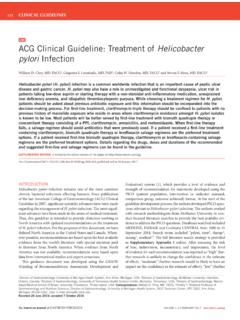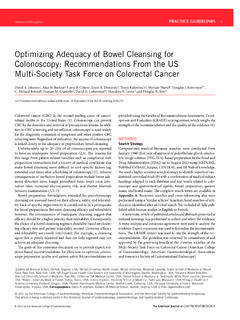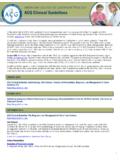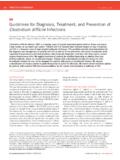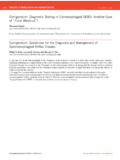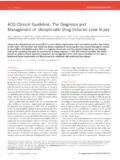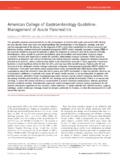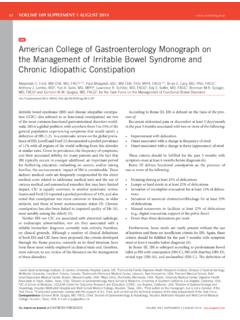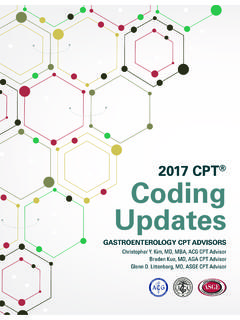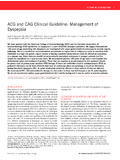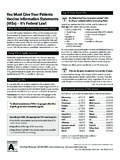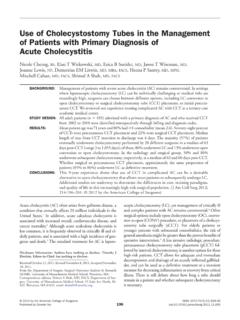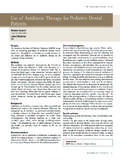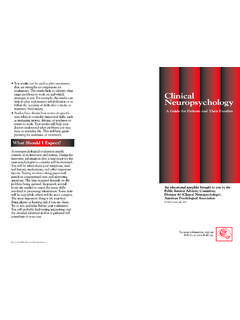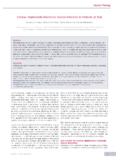Transcription of ACG Clinical Guideline: Management of Patients …
1 Nature publishing group1 2016 by the American College of Gastroenterology The American Journal of GASTROENTEROLOGYPRACTICE guidelines INTRODUCTION Acute overt lower gastrointestinal bleeding (LGIB) accounts for ~20% of all cases of gastrointestinal (GI) bleeding, usually leads to hospital admission with invasive diagnostic evaluations, and consumes signifi cant medical resources ( 1 3 ). Although most Patients with acute LGIB stop bleeding spontaneously and have favorable outcomes, morbidity and mortality are increased in older Patients and those with comorbid medical conditions ( 4 ). An individual with acute LGIB classically presents with the sudden onset of hematochezia (maroon or red blood passed per rectum).
2 However, in rare cases, Patients with bleeding from the cecum/right colon can present with melena (black, tarry stools) ( 5 ). In addition, hematochezia can be seen in Patients with brisk upper gastrointestinal bleeding (UGIB). Approximately 15% of Patients with presumed LGIB are ultimately found to have an upper GI source for their bleeding ( 6 ). Historically, LGIB was defi ned as bleeding from a source distal to the Ligament of Treitz. However, bleeding from the small intestine (middle GI bleeding) is distinct from colonic bleeding in terms of presentation, man-agement, and outcomes ( 7 ). For the purposes of this guideline, we defi ne LGIB as the onset of hematochezia originating from either the colon or the rectum ( 8 ).
3 In this practice guideline, we discuss the main goals of manage-ment of Patients with LGIB. First, we discuss the initial evaluation and Management of Patients with acute LGIB including hemody-namic resuscitation, risk stratifi cation, and Management of antico-agulant and antiplatelet agents (antithrombotic agents). We then discuss colonoscopy as a diagnostic and therapeutic tool including ACG Clinical Guideline: Management of Patients With Acute Lower Gastrointestinal Bleeding Lisa L. Strate , MD, MPH, FACG 1 and Ian M. Gralnek , MD, MSHS 2 This guideline provides recommendations for the Management of Patients with acute overt lower gastrointestinal bleeding.
4 Hemodynamic status should be initially assessed with intravascular volume resuscitation started as needed. Risk stratifi cation based on Clinical parameters should be performed to help distinguish Patients at high- and low-risk of adverse outcomes. Hematochezia associated with hemodynamic instability may be indicative of an upper gastrointestinal (GI) bleeding source and thus warrants an upper endoscopy. In the majority of Patients , colonoscopy should be the initial diagnostic procedure and should be performed within 24 h of patient presentation after adequate colon preparation. Endoscopic hemostasis therapy should be provided to Patients with high-risk endoscopic stigmata of bleeding including active bleeding, non-bleeding visible vessel, or adherent clot.
5 The endoscopic hemostasis modality used (mechanical, thermal, injection, or combination) is most often guided by the etiology of bleeding, access to the bleeding site, and endoscopist experience with the various hemostasis modalities. Repeat colonoscopy, with endoscopic hemostasis performed if indicated, should be considered for Patients with evidence of recurrent bleeding. Radiographic interventions (tagged red blood cell scintigraphy, computed tomographic angiography, and angiography) should be considered in high-risk Patients with ongoing bleeding who do not respond adequately to resuscitation and who are unlikely to tolerate bowel preparation and colonoscopy. Strategies to prevent recurrent bleeding should be considered.
6 Nonsteroidal anti-infl ammatory drug use should be avoided in Patients with a history of acute lower GI bleeding, particularly if secondary to diverticulosis or angioectasia. Patients with established cardiovascular disease who require aspirin (secondary prophylaxis) should generally resume aspirin as soon as possible after bleeding ceases and at least within 7 days. The exact timing depends on the severity of bleeding, perceived adequacy of hemostasis, and the risk of a thromboembolic event. Surgery for the prevention of recurrent lower gastrointestinal bleeding should be individualized, and the source of bleeding should be carefully localized before resection. Am J Gastroenterol advance online publication, 1 March 2016; doi: 1 Division of Gastroenterology, University of Washington School of Medicine , Seattle , Washington , USA ; 2 Chief, Institute of Gastroenterology and Hepatology, Ha'Emek Medical Center, Afula, Israel; Rappaport Faculty of Medicine, Technion-Israel Institute of Technology , Haifa , Israel.
7 Correspondence: Lisa L. Strate, MD, MPH, FACG, Division of Gastroenterology, University of Washington School of Medicine , Seattle , Washington 98104 , USA . E-mail: Received 30 July 2015 ; accepted 23 January 2016 Strate and GralnekThe American Journal of GASTROENTEROLOGY VOLUME XXX | XXX 2016 2 Table 1 . Summary and strength of recommendations Initial assessment Evaluation and risk stratifi cation 1. A focused history, physical examination, and laboratory evaluation should be obtained at the time of patient presentation to assess the severity of bleeding and its possible location and etiology. Initial patient assessment and hemodynamic resuscitation should be performed simultaneously (strong recommendation, very-low-quality evidence).
8 2. Hematochezia associated with hemodynamic instability may be indicative of an UGIB source, and an upper endoscopy should be performed. A nasogas-tric aspirate/lavage may be used to assess a possible upper GI source if suspicion of UGIB is moderate (strong recommendation, low-quality evidence). 3. Risk assessment and stratifi cation should be performed to help distinguish Patients at high and low risks of adverse outcomes and assist in patient triage including the timing of colonoscopy and the level of care (conditional recommendation, low-quality evidence). Hemodynamic resuscitation 4. Patients with hemodynamic instability and/or suspected ongoing bleeding should receive intravenous fl uid resuscitation with the goal of normalization of blood pressure and heart rate prior to endoscopic evaluation/intervention (strong recommendation, very-low-quality evidence).
9 5. Packed red blood cells should be transfused to maintain the hemoglobin above 7 g/dl. A threshold of 9 g/dl should be considered in Patients with mas-sive bleeding, signifi cant comorbid illness (especially cardiovascular ischemia), or a possible delay in receiving therapeutic interventions (conditional recommendations, low-quality evidence). Management of anticoagulant medications 6. Endoscopic hemostasis may be considered in Patients with an INR of before or concomitant with the administration of reversal agents. Reversal agents should be considered before endoscopy in Patients with an INR > (conditional recommendation, very-low-quality evidence). 7. Platelet transfusion should be considered to maintain a platelet count of 50 10/l in Patients with severe bleeding and those requiring endoscopic hemostasis (conditional recommendation, very-low-quality evidence).
10 8. Platelet and plasma transfusions should be considered in Patients who receive massive red blood cell transfusions (conditional recommendation, very-low-quality evidence). 9. In Patients on anticoagulant agents, a multidisciplinary approach ( , hematology, cardiology, neurology, and gastroenterology) should be used when deciding whether to discontinue medications or use reversal agents to balance the risk of ongoing bleeding with the risk of thromboembolic events (strong recommendation, very-low-quality evidence). Colonoscopy Colonoscopy as a diagnostic tool 10. Colonoscopy should be the initial diagnostic procedure for nearly all Patients presenting with acute LGIB (strong recommendation, low-quality evi-dence).
